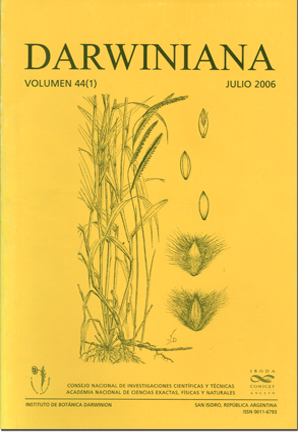THE ARID AND DRY PLANT FORMATIONS OF SOUTH AMERICA AND THEIR FLORISTIC CONNECTIONS: NEW DATA, NEW INTERPRETATION?
DOI:
https://doi.org/10.14522/darwiniana.2014.441.119Keywords:
Dry floras, floristic discontinuity, northern flora, pleistocenic lowland forest, southern flora, Andes, ChacoAbstract
In this study we aimed at testing two hypothesis about the biogeography of South America: (1) the existence of a marked discontinuity in the Andes of central Peru that separates the floras of northern and southern South America and (2) the occurrence of a more or less continuous semi-deciduous forest in South America during the Pleistocene. We conducted a search for different sources of published information on the flora (inventories) of 19 dry regions in South America as well as one region in Central America and another in North America. In order to analyze the data, we employed ordination and classification techniques, which give a more objective picture of the phytogeographical relationships. Additionally, we evaluated similarity scores between the regions. We found 1,421 woody and herbaceous genera for the 21 regions. These regions form two groups: one mostly in northern South America and the other one restricted to the southern half of the hemisphere. Within the latter, further subdivisions are discernible. Almost all the northern group is made up of tall, deciduous and semi-deciduous forest types. The southern group regions mainly range from very dry forests to desert scrub. Our results support the existence of a floristic discontinuity in relation to the drier flora of the Andes. Thesouthern flora (from southern Peru to northern Argentina and Chile) constitutes a floristic group quite different from that of northern South America. The Chaco region, although more floristically related to the southern group, seems to constitute the connecting link between these northern and southern floras. Within the flora of southern South America, the coastal desert seems to be the connection between hot and cold semi-deserts. Our data also support the hypothesis of the existence of pleistocenic lowland forests in most parts of South America which, however, probably extended up to Mexico.
Downloads
Published
31-07-2006
How to Cite
López, R. P., Larrea Alcázar, D., & Macía, M. J. (2006). THE ARID AND DRY PLANT FORMATIONS OF SOUTH AMERICA AND THEIR FLORISTIC CONNECTIONS: NEW DATA, NEW INTERPRETATION?. Darwiniana, Nueva Serie, 44(1), 18–31. https://doi.org/10.14522/darwiniana.2014.441.119
Issue
Section
Ecology and Phytogeography
License

Starting on 2012, Darwiniana Nueva Serie uses Licencia Creative Commons Atribución-NoComercial 2.5 Argentina .






